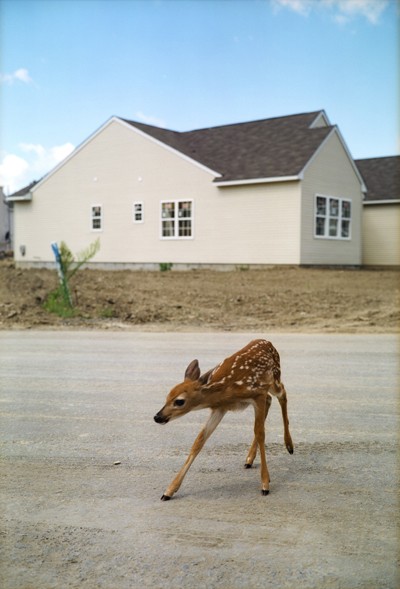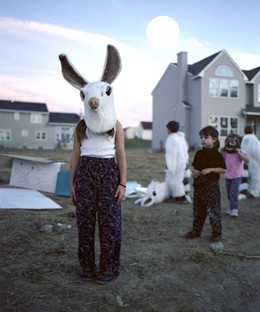
Pierre Huyghe, Still from Streamside Day, 2003 © Pierre Huyghe. Digital video projection from film and video transfers, color, sound, 26 minutes. Courtesy: Marian Goodman Gallery, New York.
The 1st at Moderna: Pierre Huyghe
Streamside Day
1.4 2005 – 29.5 2005
Stockholm
Great tractor tyres have gouged deep wounds into the land, the trees and bushes have gone. Over the hill a housing estate is springing up. The roe deer hesitates, but then carries on and enters one of the newly built detached houses. The tiny hooves clatter on the floor. We are in Streamside.
A celebration is just starting. The residents of Streamside are beginning their celebration of the housing estate’s first birthday – Streamside Day. Now we get a clear view of what the area looks like. The forest has been forced to the fringes of the neighbourhood and new trees have been planted. The animals return to it in masks worn by the children. There is nobody in front of the outdoor stage as the town supervisor and the housing developer make their optimistic speeches. Someone dressed up in cardboard boxes wanders alone between the houses. Twilight falls and the moon rises – in Streamside it is an illuminated balloon. The children cause a ruckus together, and the local police set their blue light flashing. A melancholy mood hangs over Streamside Day.

Courtesy: Marian Goodman Gallery, New York.
Pierre Huyghe’s film from 2003 is typical of his way of working – a mixture of fact and fiction. The Streamside Knolls housing estate does exist and is in New York State, near a place called Fishkill. But Streamside Day is Huyghe’s own initiative. He has staged this celebration. Nevertheless, the persons in the film are not actors; the local people play themselves.
This mixture of authentic and created reality contributes to the scope of the artwork, adding to the number of possible interpretations. Launching a communal festival day is an unusual artistic device, but in Huyghe’s case it is no anomaly. He is interested in everyday life and in ordinary people, and that includes present-day traditions and rituals, and the way they are carried out.
Streamside Day can be viewed as a fairly neutral, albeit melancholy, documentary film that can act as a template for the way a celebration might take place in the future. But it can also been seen as a comment on the profound contradictions within modern life. Celebrating traditions involves our consuming more, and contemporary rituals are therefore often initiated by the retail trade. The celebration in Huyghe’s film can be seen in relation to middle-class people’s desire to construct a safe, closed society, a gated community shielded from the original environment, the first requirement being that the life that once existed there is obliterated and excluded. The forest in the first part of the film is both paradisiacal and frightening, especially when humankind enters into it – in the guise of two small girls. The buzzing of the flies reaches an almost horror-film-like volume and is reminiscent of the way that Joseph Conrad, in his novel Almayer’s Folly, describes a forest as an intense darkness in which decay reigns.
Pierre Huyghe’s film serves as a commentary on the prefabricated society that locks people into a standardised way of living, leading to passivity and a lack of true democracy and involvement. Streamside Day creates an image of the solitude that exists in the increasingly anonymous housing estates without communal gathering places – what is known as the commercialisation and privatisation of public space. But none of this is made over-explicit in the film. For Huyghe, the things that can tell us something are all the ones that exist somewhere in between, things that are unspoken. There is no irony in his depiction of Streamside. He does not exploit the people there to convey his message. What we read into the film we read through our own references.
Huyghe often works specifically with the medium of film, and his pieces frequently deal with time and memory. By recreating situations he analyses the way that the passage of time transforms a context. The human individual in obscurity recurs in several of his works. He brings the unseen, the superficially insignificant person, out into the limelight. In Streamside Day we are shown ordinary people’s everyday lives – with their hopes of a good life and their fear of the unknown.
Pierre Huyghe often presents his films so that they activate the space where they are shown, arranging it so as to create a direct relationship with the film. In the space at the Moderna Museet there is a green wall-to-wall carpet, a tree and a wall drawing designed by Pierre Huyghe and Francois Roche. This Community Drawing is for a proposed Community Center – a kind of recreation centre or meeting place that Huyghe and Roche plan to build in Streamside. The drawing was done on the spot in the Moderna Museet by Katja and Oskar Aglert.
Curator: Camilla Carlberg
The 1st at Moderna is an exhibition programme for contemporary art. The opening is always on the first day of the month, and the exhibitions are in different venues in or outside the museum.
